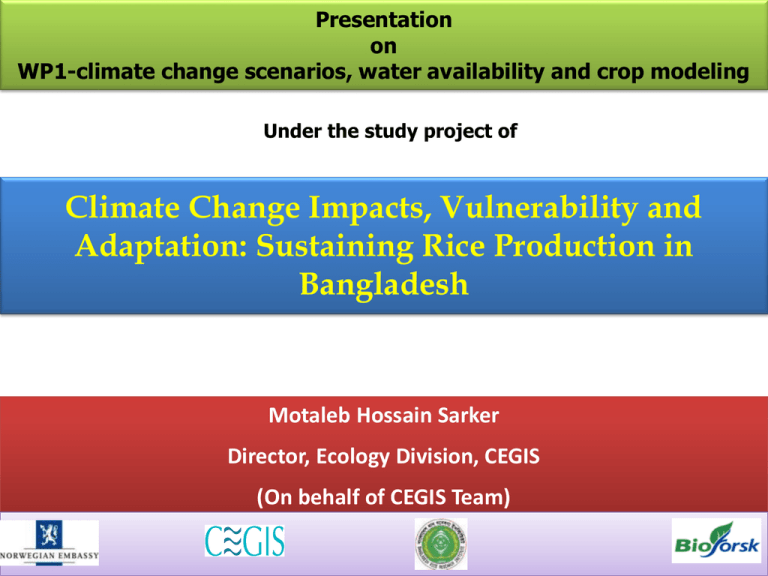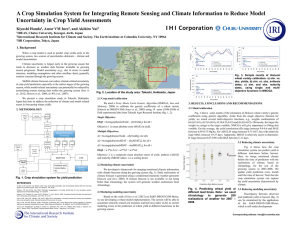here. - RICECLIMA
advertisement

Presentation on WP1-climate change scenarios, water availability and crop modeling Under the study project of Climate Change Impacts, Vulnerability and Adaptation: Sustaining Rice Production in Bangladesh Motaleb Hossain Sarker Director, Ecology Division, CEGIS (On behalf of CEGIS Team) Acknowledgement Norwegian Embassy: Specially Mr. Arne Haug, Counselor/Deputy Head of Mission We also acknowledge BRRI and Bioforsk: Specially following Experts Name Designation and organization Dr. J C Biswas Principal Agronomist, BRRI M Maniruzzaman Senior Irrigation Engineer, BRRI F I M Golam Wahed Sarker Senior Agril. Economist, BRRI Dr. M Ashiq Iqbal Khan Senior Pathologist, BRRI Dr. Nagothu Udaya Sekhar Director (Asia Projects) , Bioforsk Dr. Trond Rafoss Senior Researcher, Bioforsk Dr. Attila Nemes Senior Researcher, Bioforsk Dr. Stefanos Xenarios Senior Researcher, Bioforsk Dr. Johannes Deelstra Senior Researcher, Bioforsk Presentation Outline • Project goal and objectives • Study area • Brief methodology • Outputs and results of WP1 • Conclusions and recommendations • CEGIS Capacity in future works (Phase-II) Goal of the Study Goal of the overall study: To develop an integrated adaptation framework in order to sustain and improve the rice production under different climate change scenarios in Bangladesh Goal of the modeling exercise (WP1): - To generate the climate change scenarios - To assess the water availability using hydrological model (SWAT) - To asses the yield reduction of rice crops under different CC scenarios in Bangladesh Objectives of the work package 1(WP1) - To downscale the climate model result for generating climate variability scenarios - To generate water availability scenarios using hydrological model based on the downscaled climate models results - To assess the yield reduction of rice crop under different climate change scenarios through crop modeling - To develop the different GIS maps through GIS analysis using the model outputs - To prepare document on modeling activities and scenario generation - To assist BRRI for developing adaptation options using climate model result results through field experiments Study Area and Demography Drought prone area Saline prone area Area Population Drought prone 798,077 Saline prone 672,560 Total 1,470,637 Overall Study Approach Downscaling of climate model results Development of climate variability scenarios BRRI Hydrologic modeling and generation of water availability scenarios (SWAT) Climate Change Scenarios Water Availability Scenarios Crop Model Field experiments Dev. of adaptation options based on the model result using the field experiments (DRAS, AQUA Crop etc.) Crop production/yield reduction under different CC scenarios through crop modeling Dissemination of results to the end users (Planner, Decision Makers and Farmers) Study Methodology-Downscaling of climate model results using PRECIS Climate Change scenario: A1B : Average Emission Scenario (Rapid economic growth) A2 : High Emission Scenario (Moderate economic growth) Scenarios have been developed for the time frame: 2011-2040 (40s) 2041-2070 (70s) 2071-2100 (2100s) Results and Analysis – Downscaling of Climate Model Results Temperature and Rainfall: Gomastapur (Drought Prone Area) A 1 B A 2 High temperature in dry season •More evaporation •Increase water demand Less rainfall in dry season •Less water availability •More irrigation water need Temperature and Rainfall: Amtali (Saline Prone Area) A 1 B A 2 High temperature in dry season •More evaporation •Increase water demand Less rainfall in dry season •Less water availability •More salinity Results and Analysis – Water availability assessment using SWAT Model Water availability assessment using SWAT • SWAT an water balanced model which has been used for water availability assessment under different climate change scenarios for the study upazilas Major inputs of SWAT model: • Digital Elevation Model (DEM) • Soil Classification • Land Cover and Use • Slope • Weather Data: Rainfall, Temperature, Humidity, Solar Radiation, Wind Speed, Evaporation • Hydrological data: Discharge Water availability assessment results in drought prone area - under different climate change scenarios Scenario A1B A2 Change in water availability (%) in drought prone area Dry Season -13 -20 Wet Season 9 38 - Dry season water availability will be reduced 13% in A1B and 20% in A2 scenario - Wet season water availability will increased 9% in A1B and 38% in A2 scenarios - Wet season water availability increasing rate in A2 is high due to rainfall will be more under A2 CC scenarios condition - Increase of monsoon flow is higher for drought prone area than saline prone area Water availability assessment results in saline prone area - under different climate change scenarios Change in water availability (%) in saline prone area Scenario Dry Season Wet Season A1B A2 -15 -23 10 16 - Dry season water availability will be reduced 15% in A1B and 23% in A2 scenario - Wet season water availability will increased 10% in A1B and 16% in A2 scenarios - Dry season water availability decreasing rate in A2 is higher than A1B may be due to less dry season rainfall under A2 CC scenarios condition - Reduction of dry season flow is higher for saline prone area than drought prone area Crop Modeling (DRAS) Results : Assessment of yield reduction and water demand of crops under different climate change scenarios Crop yield reduction of drought prone areas under different Climate Change Scenarios Crop Variety Upazila Name Base Year (% of Yield Reduction) T Aus % Change of Yield Reduction 2040s 2070s 2100s A1B A2 A1B A2 A1B A2 Tanore 35 -5 -16 -5 -16 +10 -9 Godagari 34 -4 -13 -5 +3 +11 -7 Gomostapur 38 12 -6 +10 -9 +4 -2 +3 +1 -1 +11 +4 -12 +1 10 +11 +5 +4 +4 +5 -2 15 +6 +5 +2 +1 +4 -6 Tanore T Aman Godagari Gomostapur Negative sign: Yield reduction decrease/Crop production increase Positive sign: Yield reduction increase/Crop production decrease T.Aus (monsoon crop): For A1B scenarios- during 2040 and 2070 yield reduction will decreased and during 2100 yield reduction will increase. Further yield reduction will decrease for all the period (40s, 70s and 2100) except Godagari and Gomastapur under A2 Scenarios : For Forboth bothscenarios scenariosTTAman Aus production productionwill willbe beincreased decreased from base from situation base situation except A2 except (2070s) A2and (2100s) A1B (2100s) Base Year Yield YR 11% increase YR 4% YR 11% 5% Increase 4% decrease 5% increase decrease YR Increase Reduction 10% from Base from from 34% fromBase Base from Base Base 5%decrease increase YR YR 3% 4% Increase increase YR YRYR 13% YR 2% 7% decrease decrease fromBase Base from Base Base from from from from Base Base Crop yield reduction of saline prone areas under different Climate Change Scenarios Crop Variety Upazila Name Amtali T Aus Patharghata Kalapara Amtali T Patharghata Aman Kalapara Base Year (% of Yield Reduction) 8 8 7 10 % Change of Yield Reduction 2040s 2070s 2100s A1B A2 A1B A2 A1B A2 -7 -7 -4 -7 -1 -7 -6 -7 -4 -7 -1 -7 -6 -6 -3 -6 0 -6 +4 +3 +13 +4 +3 +2 11 +7 +10 +19 +12 +2 +8 8 +5 +8 +3 +4 +13 +7 Negative sign: Yield reduction decrease/Crop production increase Positive sign: Yield reduction increase/Crop production decrease For both For both scenarios scenarios T Aus T Aman production production will bewill increased be decreased from base from situation base situation Base Base Year Year Yield Yield Reduction Reduction11% 8% YR 6% 7% decrease increase YR increase YR YR YR19% 4% decrease YR2% 1%increase decrease from from from from Base Base from Base Base fromBase Base YR increase YR increase YR 10% 7% decrease YR 12% 7% decrease from Base from Base YR 7% 8% decrease increase YR from Base Irrigation Water Demand at drought prone area different Climate Change Scenarios Crop Variety Upazila Name Base Year NIR (mm) Tanore T Aus Godagari Gomostapur Tanore T Aman Godagari Gomostapur Tanore Boro Godagari Gomostapur 319 310 346 156 139 180 1087 1115 1029 Change of NIR (mm) 2040s 2070s 2100s A1B A2 A1B A2 A1B A2 -67 -65 -87 -91 +50 -41 -64 -75 -57 -32 +51 -57 -65 -64 -77 -17 +73 -80 +72 +42 +37 +12 +66 +1 +70 +39 +42 +50 +68 -32 +61 +31 +40 +43 +76 -23 +38 -64 +58 -70 +66 -33 0 -98 +22 -106 +26 -72 +19 -74 +37 -75 +61 -71 Negative sign: Irrigation water demand will be decreased Positive sign: Irrigation water demand will be increased Irrigation water demand maps for winter rice (Boro) crop under different CC Irrigation Water Demand for T Aman Crop Irrigation Water Demand scenariosfor T Aus Crop Irrigation Water Demand under different Climate Change ScenariosSaline Area Change of NIR (mm) Base Upazila Crop 2040 2070 2100 Year Name Name A2 A1B A2 A1B A2 (NIR (mm) A1B Amtali T Aman Patharghata Kalapara Amtali T Aus Patharghata Kalapara Amtali Boro Patharghata Kalapara 97 125 81 117 106 101 881 835 848 +21 +11 +49 +32 +29 +70 +22 +30 +51 -78 -111 -43 -57 -99 -23 -66 -95 -30 +17 -57 +9 +10 -40 +30 +16 -61 +10 +23 +44 +39 -93 -80 -78 -61 -42 -61 +19 +25 +18 -8 +6 -3 +38 +36 +37 Negative sign: Irrigation water demand will be decreased Positive sign: Irrigation water demand will be increased +7 +27 +22 -86 -73 -67 -22 -10 -34 Conclusions Incase of Drought prone area •Dry season water availability will be reduced 15% in A1B and 23% in A2 scenario. Wet season water availability will increased 10% in A1B and 16% in A2 scenarios •Dry season water availability decreasing rate in A2 is higher than A1B may be due to less dry season rainfall in under A2 CC scenarios condition •Increase of monsoon flow is higher for drought prone area than saline prone area Incase of saline prone area •Dry season water availability will be reduced 15% in A1B and 23% in A2 scenario. Wet season water availability will increased 10% in A1B and 16% in A2 scenarios •Dry season water availability decreasing rate in A2 is higher than A1B may be due to less dry season rainfall under A2 CC scenarios condition •Reduction of dry season flow is higher for saline prone area than drought prone area For both scenarios T Aman production will be decreased from base situation except A2 (2100s) in drought prone area For both scenarios T Aman (monsoon) crop production will be decreased from base situation in saline prone area. But T.Aus (pre-monsoon) crop production will increase Recommendations • Higher resolution climate model downscaled results very essential. Research fellowship can be introduced in the second phase of the project to get high resolution CC result can be obtained from ICTP Italy. • Sensor based climate and other field data collection is highly essentials for the local level adaptation strategy formulation • Model performance can be improved based on secondary and primary information (sensor based data) of water availability • Not only water controls the yield, nutrient with water is also essential. Thus influence of nutrient is essential to adapt yield reduction • Water availability estimation should be based on quality and quantity • Couple of salinity intrusion and water availability model can use in coastal area • Field level implementation of DRAS and AquaCrop model should be enhanced for scheduling of real time irrigation • For better crop production Project Stakeholder Advisory Committee will demonstrate new technology to the farmers Future activities • Union wise water scarcity can be studied through assessing water availability using GIS/RS based model • Development of Local level Adaptation Plan for Action (LAPA) is very essential. Union wise LAPA can developed considering climate induced disasters and agro-ecological zones • Assessment of climate change impact on livelihood for the local level adaptation strategy formulation • Agricultural Water Management Committee or Group formation under Triple (PPP) system providing technology based irrigation scheduling and fertilizer recommendations • Study on sensor based field data collection by DAE field officials and farmers • Field level implementation of DRAS and AquaCrop model at DAE. Training for Union Agriculture Officers for growing more crop using less irrigation water Thank You



